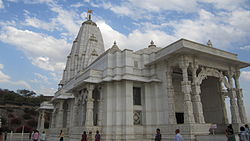





TheBirla Mandirs (Birla Temples) refer to differentHindu temples orMandirs built by theBirla family in different cities across India. All these temples are magnificently built, some in white marble or sandstone. The temples are generally located in a prominent location, carefully designed to accommodate a large number of visitors. The worship and discourses are well organized. The first one was built in 1939 in Delhi collectively byJugal Kishore Birla and his brothers and their father. Later temples were built by and managed by different branches of the family. For both of the temples in Varanasi, the Birlas joined other donors to support the cost.
The Birla temples in Delhi and Bhopal were constructed to fulfill a cultural void in these cities. As these cities were ruled for centuries by Muslim dynasties, these cities did not have any notable temples since the Islamic ruler did not permit the construction of grand Hindu temples withshikharas. Delhi, even though it was the capital of India, did not have any outstanding Hindu temples left. During the Mughal period, temples with a shikhara were prohibited until the late Mughal period. The first temple to be built by the Birla family is the Laxminarayan Temple in Delhi, which was opened in 1939. Located at a prominent site,[1] The temple was designed to be lofty and spacious, suitable for congregational worship or discourses. Although built using modern technology, it very loosely conformed to theNagara style. The Birlas also built the adjoining Buddhist temple and donated it to theMahabodhi Society.[citation needed]
The Birla temples in Delhi, Banaras and Bhopal use modern construction materials and techniques. Later temples are built of marble or sandstone and are constructed usually in the classical style ofMāru-Gurjara architecture (from theChandela orChaulukya dynasty) of the 10-12th century, with some elements of local, regional styles, such as thegopuram of theBirla Mandir, Hyderabad, otherwise in the northern Māru-Gurjara style. The Saraswati temple, in the BITS Pilani campus, is one of the very few Sarasvati temples built in modern times (seeSharda Temple, Maihar). It is said to be a replica of theKandariya Mahadeva Temple ofKhajuraho; however, it is built of white marble and adorned with not only images of Gods but also of philosophers and scientists.[2] The Gwalior Sun temple is a replica (much reduced in size) of the famousKonark Sun Temple,[3] as it would have appeared before the collapse of the main tower. Anne Hardgrove states:
| Image | Temple | Year | Location | Deity |
|---|---|---|---|---|
 | Birla Mandir | 1931-1966 | BHU,Varanasi | Shiva (Shri Vishwanath) |
 | Laxminarayan Temple[5] | 1939 | Delhi | Lakshmi Narayan |
 | Buddhist Temple (Delhi Center) | 1939 | Delhi | Dharmachakra Pravartana Buddha |
| Birla Mandir | 1941 - 1961 | Kanpur | Lakshmi Narayan | |
| Birla Mandir[6] | 1955 | Kurukshetra | Krishna | |
 | Birla Mandir (Sharda Peeth)[7] | 1956-1960 | BITS Pilani | Saraswati |
| Birla Mandir[8][9][10] | 1957 | Kurnool | Laskhmi Narayan | |
 | Lakshmi Narayan Temple, Bhopal[11] | 1960 | Bhopal | Lakshmi Narayan |
| Tulsi Birla Manas Mandir | 1964 | Varanasi | Ram | |
 | Birla Mandir | 1965 | Shahad | Vithoba |
 | Renukeshaw Mahadev Temple | 1972 | Renukoot | Shiva |
 | Birla Mandir[12] | 1966-1976 | Hyderabad | Venkateswara |
 | Birla Mandir[13][14] | 1976-1996 | Kolkata | Radha Krishna |
 | Birla Mandir[15] | 1984-1988 | Gwalior | Surya |
 | Birla Mandir | 1988 | Jaipur | Lakshmi Narayan |
| Birla Mandir | Patna | Lakshmi Narayan | ||
| Birla Mandir | Akola | Rama | ||
| Birla Mandir | Nagda | Vishnu | ||
| Birla Mandir[16] | Alibaug | Ganesha | ||
| Birla Mandir[17] | Brajarajnagar | Laxmi Narayanan | ||
| Birla Mandir | Veraval | Lakshmi Narayan | ||
 | Birla Radha Krishna Mandir | 2023 | BITS Pilani Goa | Radha Krishna |